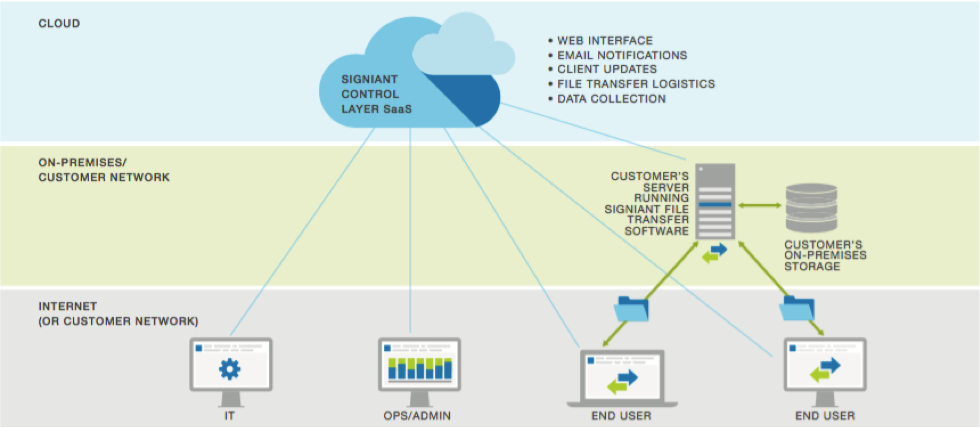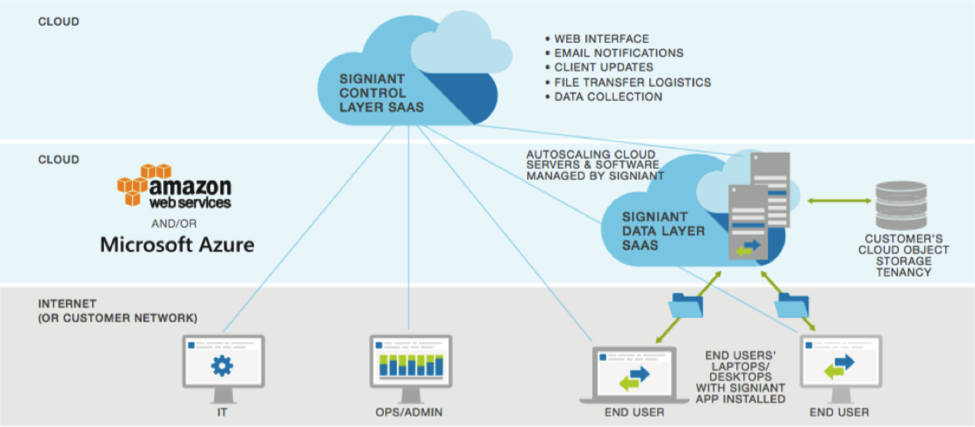Freedom and Flexibility in Cloud-Based File Sending and Sharing – It’s All About the Storage
We recently wrote an article that outlined Nine Pitfalls of Relying on FTP to Move Large Media Files. The list included drawbacks such as their lack of file transfer acceleration, file size limits, absence of centralized control and visibility, and so on. The article concludes with a description of the many key features that our cloud-native SaaS solution for person-initiated transfers – Media Shuttle – has to avoid the limitations of such tools, and to provide the types of capabilities needed by an industry where content really is “king”.
Here we wanted to pick-up on one theme from that article: how differently Signiant approaches storage to these other solutions. To understand this difference, it is first necessary to understand why our approach is different, and that means recognizing a more fundamental distinction: Signiant is not an advocate for moving everything to the cloud.
We are definitely not against it, and we do strongly believe in the benefits of cloud-native SaaS as a service delivery model. But, when it comes to their valuable content, our position is simply that our customers know best for themselves what and when to move to the cloud, and that this will be different for everyone according to their needs, priorities, constraints and concerns. Our role as we see it is to ensure that we have solutions that will support whatever choices our customers make about where to store their content, and to ensure that if they later change their mind we provide the flexibility to seamlessly support that too.
What do we mean by “Storage Independence” in Media Shuttle?

Media Shuttle Architecture if On-Premises Storage is Selected
In the case of Media Shuttle, we always deliver at least part of the solution as a true SaaS. So the part that provides the web interfaces, all the tracking and reporting, the file transfer logistics, the client updates, and some other features like email notifications, is always delivered from the cloud, as a service hosted and managed by Signiant. But on the storage side customers have the choice between keeping their data in on-premises file storage, or in object storage provided by public cloud platforms (currently Amazon Web Services S3 and Microsoft Azure Blob storage are supported), or mixing and matching across the different customer’s portals. Where cloud storage is selected, the entire solution is delivered as a SaaS – with Signiant also hosting and managing the data transfer servers in the cloud. Where on-premises storage is selected the customer needs to install the Signiant server software on-site alongside the storage.
This is what we mean when we talk of “storage independence” or “storage freedom”.
With Media Shuttle, not only is the customer free to choose between any of these choices, on a per portal basis, they are also not “locked in” to their choices. Switching between on-premises and cloud storage is as simple as reconfiguring where the individual portals “point to” for the content. And the same is true for switching between cloud storage vendors. The technical effort is minimal, users will never see a difference, and the business implications – as these relate to Signiant’s pricing – are similarly either zero or minimal, depending only on whether or not there is a significant change in total cloud payload used (and only if above the associated free allocation that comes with every Media Shuttle tier subscription). There is no fee for switching (or adding) storage type or cloud vendor, and no extra costs in terms of adding portals or any software needed to support them.
None of the types of online file sending and sharing platforms – which are, like Media Shuttle, all cloud-native SaaS solutions – support this kind of independence or freedom when it comes to storage. The storage is simply whatever is provided by the vendors themselves, somewhere in the cloud, but with no choices available and no freedom to use alternative cloud storage, much less on-premises storage.
But this is only part of the story of the limitations around storage with these solutions, and how Signiant is different. The other part relates to cloud storage itself, and the very different way in which Media Shuttle supports this.
Control, Flexibility and Freedom in the Cloud – the Media Shuttle Advantage
When using cloud storage with these other vendors the customer has no visibility or control over that storage – they don’t even know what region in the world their files are physically located, or how they are managed and protected. It is a black box to the customer, hardwired into the solution. You can choose how to organize your content in terms of how it presents in the web interfaces, and, through those interfaces, you can control things like who has rights to upload, download, view, send and share, delete and modify, files or folders; but that is all.
Signiant, however, does not provide or re-sell cloud storage – or any kind of storage – for Media Shuttle, or any of our solutions. It is the responsibility, but also the freedom, of the customer to supply this. With cloud storage this means the customer connects their own cloud tenancy – AWS and/or Azure today – to those portals for which they wish to use cloud storage.

Media Shuttle Architecture if Cloud Storage is Selected
The first advantage of this, versus the alternative cloud-based file sharing platforms, is the customer has far greater control, access and visibility of their own cloud storage, how it is managed and organized, and also what they do with their content once there. And this leads to the second advantage, which is that customers are able to utilize additional cloud services and tools provided by the cloud vendor, or from third parties who have built their own compatible cloud services, or even use tools the customer builds and deploys in the cloud themselves.
In the M&E world these tools and services could be anything from transcoding or rendering, to cloud-based media asset management (MAM) and file QC, metadata aggregation and AI tools, localization services and distribution platforms, even cloud-based editing and playout – whatever runs, or can be made to run, in the cloud platform of the customer’s choice. The possibilities are almost endless, and while few would suggest that all of them make equal sense in all situations for all customers, it is equally true that examples of all of these are already in production across a wide and growing cross-section of the M&E industry.
In reality there are often good reasons for not using the cloud for all (or even any) of your content. Different classes of assets need to be stored in different ways. Especially in data intensive media operations projects, it’s important to be able to have the flexibility to choose on a case-by-case basis what kind of storage to use. At a certain scale, on-premises storage can be a cheaper option than cloud storage, and it gives you control over performance and availability. In cloud, availability is defined for you and is associated with a cost. Cloud egress charges in particular can add up significantly if content needs to be frequently downloaded.
Given all of the above, more and more M&E companies look to take a “hybrid cloud” approach, where content and tools exist both on-premises and in the cloud, with services deployed that are able to efficiently bridge and optimize workloads across these hybrid environments. As this approach becomes easier the industry is witnessing a clear and growing movement to migrate selected content and processes to the cloud. Our eBook The Cloud: Revolutionizing the Media Business From Above, produced in conjunction with NewBay Media, examines some of the themes, trends and challenges of this new reality.
With the standard online file sharing platforms none of this is possible. They offer no mechanisms for connecting additional media-centric cloud services to your content on the storage that they provision and manage in the cloud. And of course they offer no support for utilizing on-premises storage either.
There are multiple reasons for selecting Media Shuttle over the more generic online file sharing platforms – such as speed, security, etc. However, our emphasis on “storage independence” is especially important for any forward-looking media company seeking freedom and flexibility as to how they store and process their valuable content. Media Shuttle allows for storage elasticity and the ability to accommodate different storage requirements over time so that businesses can choose the storage – and associated tools and services – that makes the most sense for different projects now and in the future.
When considering other options for sending and sharing your large files, whether these are the online file sharing platforms, other widespread alternatives such as FTP, or even our more direct competitors, it pays to look closely at what the options are around storage. How easy is it to mix and match between on-premises and the cloud? How free are you to select, add, or switch between cloud storage providers? What can you actually do with your content once it is on these platforms, other than simply send and share? How well do they support a hybrid environment?
Whatever your position on the cloud, when it comes to how you send and share your files, storage freedom is the key to business flexibility.


